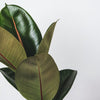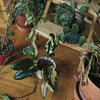8 air purifying plants
The air quality in our homes has deteriorated dramatically over the past 10 years. Very tightly constructed buildings cause less air circulation and keep many pollutants and harmful substances inside. The cause of the deterioration is also often errors in the heating, ventilation, excessive humidity or air conditioning systems.
Exhaust gases, volatile organic substances and light industrial chemicals emit many toxic substances into the air (formaldehyde, toluene, ammonia, etc.). We should keep in mind that these substances can also be carcinogenic. However, mold, improper ozone ventilation (often a by-product of office machines) or insufficient fresh air filtration are also harmful. Of course, the situation is even worse in smoking areas.
In 2002, the World Health Organization announced that almost 60% of the population of developed countries suffer from the so-called Sick Building Syndrome , better known by the abbreviation SBS. Symptoms of this disease are irritation of the eyes and nose, rashes, increased skin sensitivity or, in the longer term, the development of allergies.
In today's article, I have selected 8 air-purifying plants , thanks to which our breathing should be easier and healthier. I drew from the official NASA study . Their first research focusing on this issue was published in 1989 and was later expanded.
Here is a link to a study called Interior Landscape Plants for Indoor Air Pollution Abatement. 
1. Spathiphyllum
Lopatkovec will win over everyone with its beautiful and elegant appearance, and even beginners will be pleased by the fact that it is used to harsh conditions. As one of the few indoor plants, it is also suitable for those who do not have much time to care for houseplants. It loves moisture, partial shade, but in winter, on the contrary, as much light as possible.
This tropical plant comes from Colombia, where it can reach a width and length of one meter. In our domestic conditions, it is formed by bushes of medium height. Quiver-shaped inflorescences (exaggerated bracts covering the inflorescence) appear between the pointed leaves, which is why you can find the plant under the name quiver. The flowers on the plant can be found from April to September, before they dry, their color changes to light green.
Lopatkovec absorbs all possible harmful substances (benzene, formaldehyde, ammonia, toluene and trichlorethylene). But we have to be careful, as it is toxic and therefore not suitable for households with children or pets.

On our e-shop you can also find a variegated variant: Spathiphyllum Diamond variegata .
2. Mother-in-law's tongue (Sansevieria)
Tenura or mother-in-law's language has many more names than just these two. We would also find this maid under terms such as snake plant, snake or devil's tongue, or St. George's sword. It is probably so named because of the appearance of its pointed, hard and sharp leaves, most typically green-yellow tinged.
This plant comes from West Africa (it grows in the zone from Nigeria to the Congo). It is again suitable for complete beginners, as it is known for its unpretentiousness, longevity, preference for shady areas and requires less frequent watering (once every 2-3 weeks).
Absorbs formaldehyde, benzene, trichlorethylene and toluene. Unfortunately, it is also not suitable for living with children or pets, it is highly toxic.

In our e-shop you can also find other variants, e.g. sansevieria cylindrica , Laurentia or Masoniana .
3. Anthurium
We can usually recognize toulitky as cut flowers with distinctly red or white bracts. At first glance, they may even look artificially made of wax. But let's not be confused, the anthurium genus is made up of approximately 825 diverse species and is the largest of the entire Araceae family.
It originally comes from the humid tropical forests of South and Central America. Unlike the previous ones, toulitka is more suitable for more advanced growers, because it is prone to attack by pests (spots, thrips, worms...). It is a heat-loving plant that is very sensitive to drafts or watering that is too cold. The best place to place it is an east-facing window, it can't stand direct sunlight.
This room absorbs the pollutants formaldehyde, toluene, xylene and ammonia. However, we must be careful, as it contains substances that irritate the mucous membranes and is toxic, it is not suitable for pets and children.

4. Dracaena
These fake palm trees are elegant, unpretentious, long-lived and suitable for any interior. Their original homeland is the tropical regions of Africa and Asia, but due to the high number of species they are also found on the Canary Islands. The most famous species is Dracaena marginata with long leaves that taper to a tip.
In domestic conditions, this dragon plant can grow up to three meters high, but we need to know how to care for it. It does not like drafts and direct light, as its leaves could burn, so care must be taken in its correct location. At the same time, it loves high humidity because of its homeland.
Among other things, we can also meet the species Dracaena fragrans or deremensis. The dragon fruit is therefore suitable even for beginner growers. In addition, as a bonus, it absorbs benzene, formaldehyde and trichlorethylene, unfortunately it is toxic.

5. Aglaonema
Agalonema, also known as "sleeping maiden", is a perennial herb from the Aron family, usually with spotted leaves (most often white-green or red-green). It has small flowers and its fruit are berries. These houseplants are grown in the tropics or subtropics, but most often they are used as greenhouse ornamental plants in botanical gardens.
The flowers of this indoor plant are found only in summer and their color is white or yellow. Although the plant is suitable for beginners, we must not forget to water it, because it loves a moist environment. Like, for example, scapulae or philodendrons, it enjoys semi-shade, it does not like direct light, because it can be attacked by the pests of squills if there is too much light. Like the previous maids, she doesn't like drafts.
It removes benzene and formaldehyde from the air, but its leaves contain oxalic acid, which is why it is toxic to dogs, cats and children if bitten.

6. Aloe vera
I think there is no need to introduce this plant at length. Thanks to its beneficial effects and a wide range of uses, it has become very widespread. It is a medicinal, healing and ornamental plant. Pure aloe vera gel is non-toxic and suitable for application to burns, abrasions and minor injuries.
The exact origin of this maid is not known, but due to extensive research, its homeland is the Arabian Peninsula. Aloe vera is known for its long pointed leaves with jagged edges. Since it is a succulent, overwatering tends to be a problem when caring for it. It is recommended to water once every 3-4 weeks. It is advisable to place aloe in a bright place, it needs 8-10 hours of light a day.
Aloe vera takes "only" benzene and formaldehyde from the air. Although I have already mentioned its beneficial effects, it is not suitable for pets or children, as they may have digestive problems after consuming it.

7. Ficus (Ficus)
The ficus, also known as the fig tree, is a popular house plant, perhaps also because it can be grown as a bonsai - let's not be fooled, some species in its homeland grow to a height of 30 m, in our conditions they reach up to 200 cm. The most widespread species is the rubber ficus (ficus elastica), and by analyzing the etymology of the Czech name, we can conclude that fig trees are used to produce rubber.
It comes from the tropical regions of South and Southeast Asia. Caring for it is not difficult at all, because it does not require to be right next to the window. It will do well even in heated apartments, as thanks to its leathery leaves it can withstand higher temperatures, and it doesn't mind dry air either.
We water little, just like aloe, under suitable conditions it does not suffer from diseases or pests. In the interior, it serves as a natural air purifier, it is harmful to pets and children.

On our e-shop you can also find other variants, e.g. Ficus Lyrata , elastica Robusta or variegated Ficus elastica Tineke .
8. Philodendron (Philodendron)
Unlike the others already mentioned, this robust perennial herb has an interesting way of life. In tropical America, it is commonly found in treetops, on rocks or in swamps. Just like here, it is used for the pleasure of the eye. The genus includes about 500 species.
An interesting feature of the life of philodendrons is the temperature reached during pollination - scientists measured an incredible 43 °C. In our conditions as houseplants, some are suitable for growing for beginners, some for advanced, it depends on the specific species. However, in general we could say that they love moisture and partial shade.
Philodendrons absorb carcinogenic formaldehyde from the air and are toxic due to their oxalic acid content. Therefore, they are not recommended for households with pets and children.

I hope that you were interested in this article and managed to outline the issue of SBS, which, in my opinion, many people are not even aware of. I think it is in the interest of the health of each of us to get a houseplant for home, but also for the office - it will not only please the eye, but also improve the air quality.




